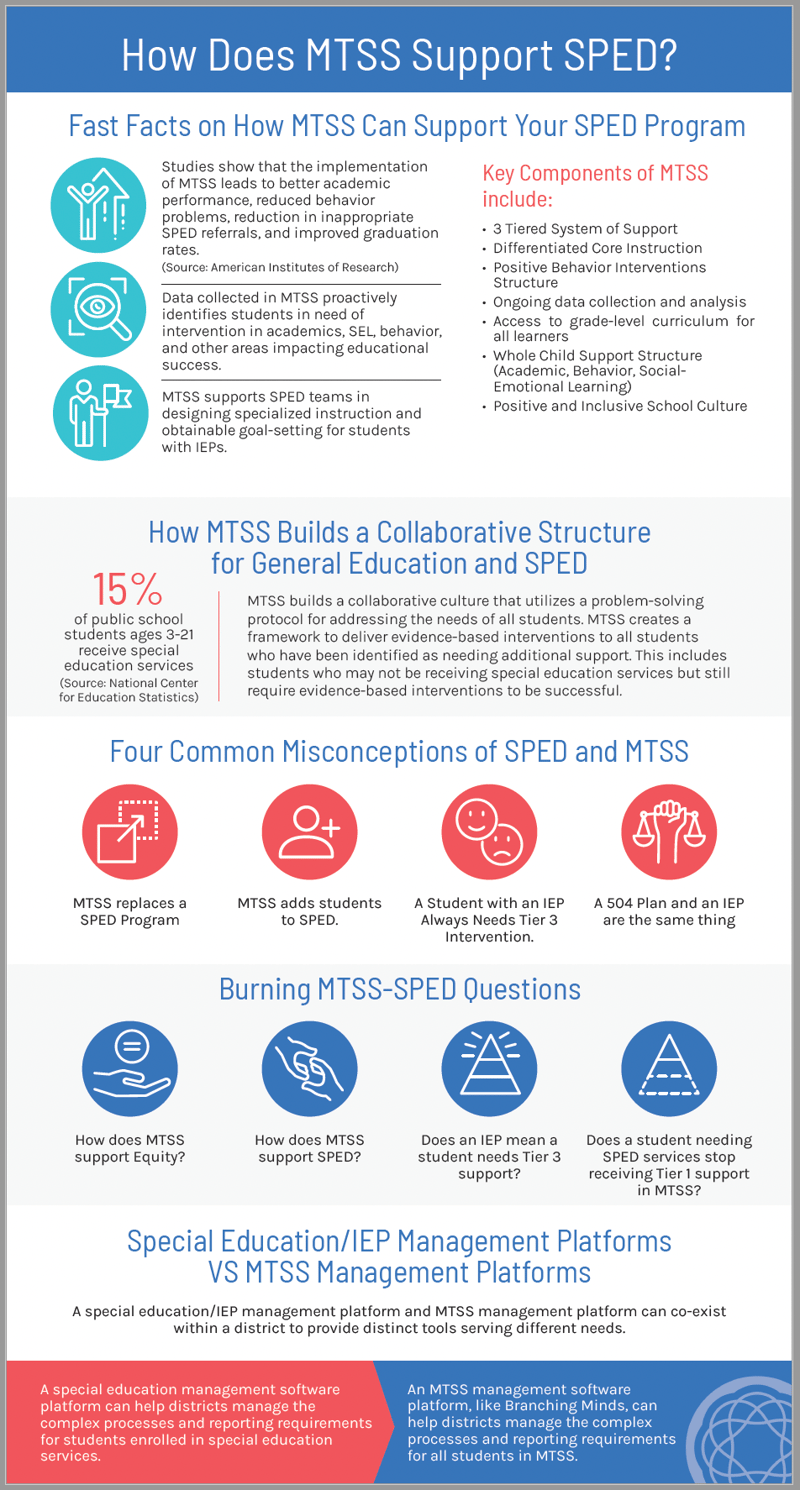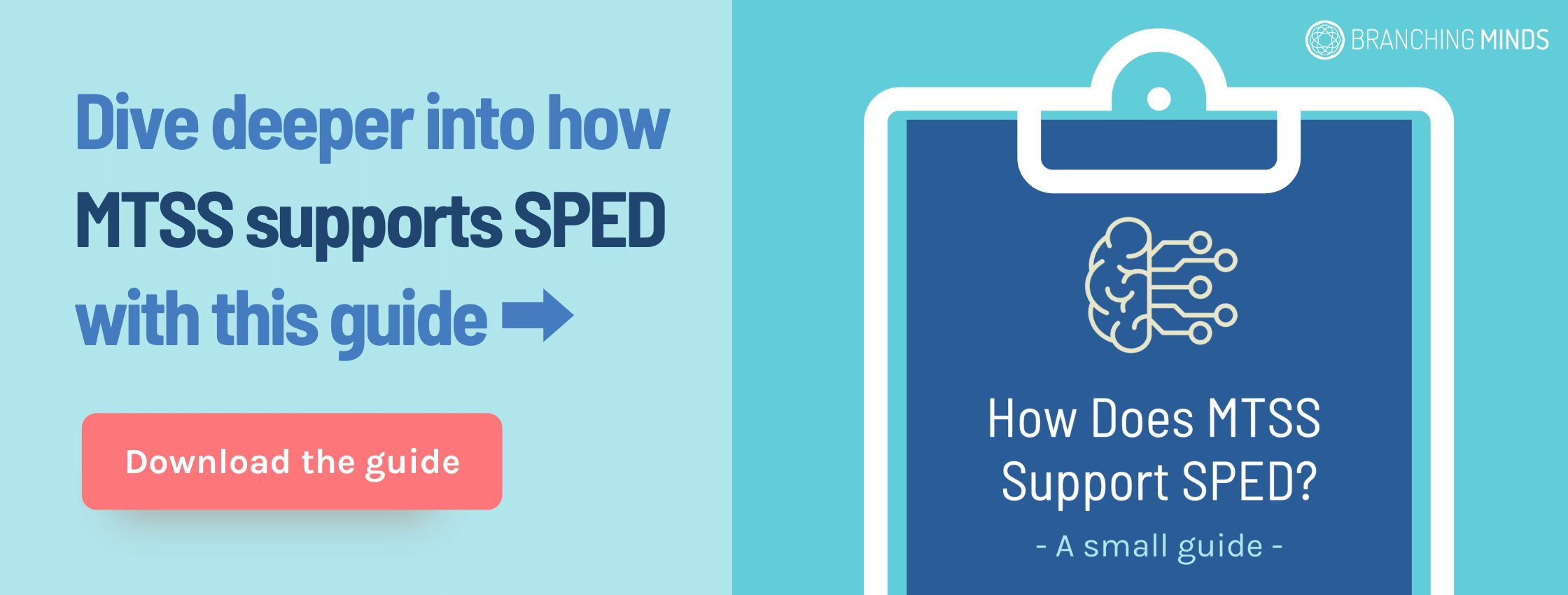Special Education (SPED) and Multi-Tiered System of Supports (MTSS) are not the same things. However, they both exist to support all students in achieving success in education and in life. MTSS helps structure support for all students in a holistic framework, including students with disabilities. For those students with a qualified disability, SPED provides specialized services through an individualized education program, or IEP.
MTSS helps provide the right instruction for every student in a school, including students with disabilities.
There are lots of misconceptions about MTSS and SPED. We’ve compiled answers to some of the top questions we receive when discussing special education and MTSS. In addition, we have also created an infographic that you can share with your team to understand how MTSS and SPED align to help every student succeed.
NAVIGATE THIS ARTICLE:
-
Common Misconception #3: A Student with an IEP Always Needs Tier 3 Intervention.
- BONUS GUIDE - How Does MTSS Support SPED?
Common Misconception #1: Does MTSS Replace a SPED Program?
Short answer? No.
Long answer? Still no, but let’s explain why.
MTSS and SPED work together to support all students, including students with disabilities. But MTSS cannot replace a SPED program.
MTSS is a systematic support structure that provides tiered interventions for all students with academic, social-emotional learning, and behavior needs. Through universal screening assessments, students at risk for not meeting grade-level expectations are quickly identified and provided with interventions.
While MTSS can help improve school culture, increase student performance, and decrease negative behaviors, it does not fulfill the legal requirement of services for students with disabilities required by law under the Department of Education (IDEA) and individual state mandates. That is where a special education program comes into play.
This does not mean MTSS does not also support students with disabilities. If MTSS is implemented with fidelity, assessment data for each student is readily available. This data is used to improve the effectiveness of the students’ instruction/interventions and can be used as a required part of the evaluation procedure for a SPED referral.
Even if a child is receiving SPED services, the student continues to receive support through the problem-solving system of MTSS. Rather than replacing a SPED program, MTSS provides a system of early identification for at-risk students, access to core curriculum for all students, evidence-based interventions, and readily accessible assessment data for each student.
Common Misconception #2: MTSS Adds Students to SPED.
In MTSS, three tiers denote the intensity of resources needed to help a student succeed. These tiers do not represent categories or groups of students, nor do they represent procedures or programs.
Universal screening assessments and benchmark assessments are used to identify which students require additional support beyond their core instruction. Students with intervention plans are consistently assessed to determine if the plans are effective and if a student is making progress. This means a lot of data for every student.
MTSS does not add students to SPED, but it can help identify students with a possible disability requiring special education services.
If the team suspects that a student may meet eligibility guidelines for a disability category, then special education evaluation and IEP team are called to make this determination. This could occur while a student receives Tier 1, Tier 2, or Tier 3 support. In addition, once a student begins to receive special education services, that student can continue to receive MTSS support, including access to core instruction and tiered-level resources.
Common Misconception #3: A Student with an IEP Always Needs Tier 3 Intervention.
An IEP, Individualized Education Plan, is a written plan that describes the individual learning needs of a student with disabilities. This includes the SPED services, supports, aids, accommodations, and modifications that will be provided to that student. IEPs are provided to students with disabilities who qualify for special education services.
Tier 3 is the highest intensity of intervention provided through MTSS. Tier 3 interventions are individualized interventions based on student data collected during the problem-solving cycle. These interventions occur in small student-teacher ratios (ideally 1-on-1), may occur for a longer duration of time than Tier 2 interventions, and target a specific skill identified through data. Roughly 5-10% of students within a school will require this level of intervention.
Having an IEP does not immediately identify a student as needing Tier 3 intervention.
Students with IEPs can access core instruction and tiered-level resources based on their level of need within a content area, social-emotional capacity, or behavioral need. SPED staff oversee specialized interventions for the students. Based on the student’s IEP, Tier 3 interventions may or may not directly support an IEP goal.
An IEP does not immediately qualify a student for Tier 3, nor is Tier 3 reserved only for students with IEPs. Instead, Tier 3 is provided to any student who needs this level of intensive instruction. This includes students who do not have an IEP.
This also holds true for Tier 1 and Tier 2. A student who has an IEP can access core instruction and Tier 2 intervention at any time a need is determined. This is true for all students in MTSS—which is all students in a school.
![[Guest Author] Mollie Breese-avatar](https://www.branchingminds.com/hs-fs/hubfs/Team/Mollie%20Breese%20Headshot-1-1-2-1.jpeg?width=82&height=82&name=Mollie%20Breese%20Headshot-1-1-2-1.jpeg)
About the author
[Guest Author] Mollie Breese
Mollie Breese is the former Content Manager at Branching Minds. She helped streamline the support library, so schools can identify and access the interventions they need to support student success. She researched the newest strategies, activities, and programs to add to the robust library, providing a wealth of resources for partner schools. Prior to joining Branching Minds, Mollie worked in the classroom as an English teacher, Reading teacher, and ESL instructor. Mollie earned her B.A. in Political Science from the University of Missouri, and her M.A. in English Literature from the University of Glasgow.

Your MTSS Transformation Starts Here
Enhance your MTSS process. Book a Branching Minds demo today.



















.jpg?width=716&height=522&name=Better%20MTSS%20Meetings%20Blog%20(preview).jpg)
